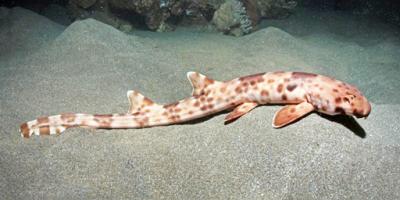Difference between revisions of "AY Honors/Species Account/Hemiscyllium Halmahera"
JadeDragon (talk | contribs) (edits and photo) |
m (W126jep moved page Adventist Youth Honors Answer Book/Species Account/Hemiscyllium Halmahera to AY Honors/Species Account/Hemiscyllium Halmahera without leaving a redirect: Part of translatable page "Adventist Youth Honors Answer Book/Species Account/Hemiscyllium Halmahera") |
||
| (2 intermediate revisions by the same user not shown) | |||
| Line 1: | Line 1: | ||
| + | <noinclude><translate><!--T:1--> | ||
| + | </noinclude> | ||
{{species id | {{species id | ||
|common_name=Indonesian Walking Shark | |common_name=Indonesian Walking Shark | ||
| Line 5: | Line 7: | ||
|description=They get their name because they appear to walk along the sea floor. The walking sharks grow up to 27 inches (70 centimeters) long and are harmless to humans. H. halmahera has a light brown colour with leopard-like dark brown spots alternating with scattered white spots. Unlike similar species, it has relatively few spots on the snout.[https://www.youtube.com/watch?v=nqzl2PvPMGc Walking shark (and other interesting sharks) video] | |description=They get their name because they appear to walk along the sea floor. The walking sharks grow up to 27 inches (70 centimeters) long and are harmless to humans. H. halmahera has a light brown colour with leopard-like dark brown spots alternating with scattered white spots. Unlike similar species, it has relatively few spots on the snout.[https://www.youtube.com/watch?v=nqzl2PvPMGc Walking shark (and other interesting sharks) video] | ||
|range=The Hemiscyllium Halmahera is named after the island of Halmahera in North Maluku Province, where it is found exclusively.It was first discovered in 2008 by a diver and widely published in 2013. Six of the nine known species of walking sharks are found in Indonesia. The group is called epaulette sharks, since many sport markings that resemble military epaulettes. This class of sharks do not cross areas of deep water and are found in isolated reefs throughout Indonesia and other western Pacific waters.}} | |range=The Hemiscyllium Halmahera is named after the island of Halmahera in North Maluku Province, where it is found exclusively.It was first discovered in 2008 by a diver and widely published in 2013. Six of the nine known species of walking sharks are found in Indonesia. The group is called epaulette sharks, since many sport markings that resemble military epaulettes. This class of sharks do not cross areas of deep water and are found in isolated reefs throughout Indonesia and other western Pacific waters.}} | ||
| + | <noinclude></translate></noinclude> | ||
Latest revision as of 20:26, 20 September 2021
Indonesian Walking Shark (Hemiscyllium Halmahera)
Where found: The Hemiscyllium Halmahera is named after the island of Halmahera in North Maluku Province, where it is found exclusively.It was first discovered in 2008 by a diver and widely published in 2013. Six of the nine known species of walking sharks are found in Indonesia. The group is called epaulette sharks, since many sport markings that resemble military epaulettes. This class of sharks do not cross areas of deep water and are found in isolated reefs throughout Indonesia and other western Pacific waters.
Description: They get their name because they appear to walk along the sea floor. The walking sharks grow up to 27 inches (70 centimeters) long and are harmless to humans. H. halmahera has a light brown colour with leopard-like dark brown spots alternating with scattered white spots. Unlike similar species, it has relatively few spots on the snout.Walking shark (and other interesting sharks) video

